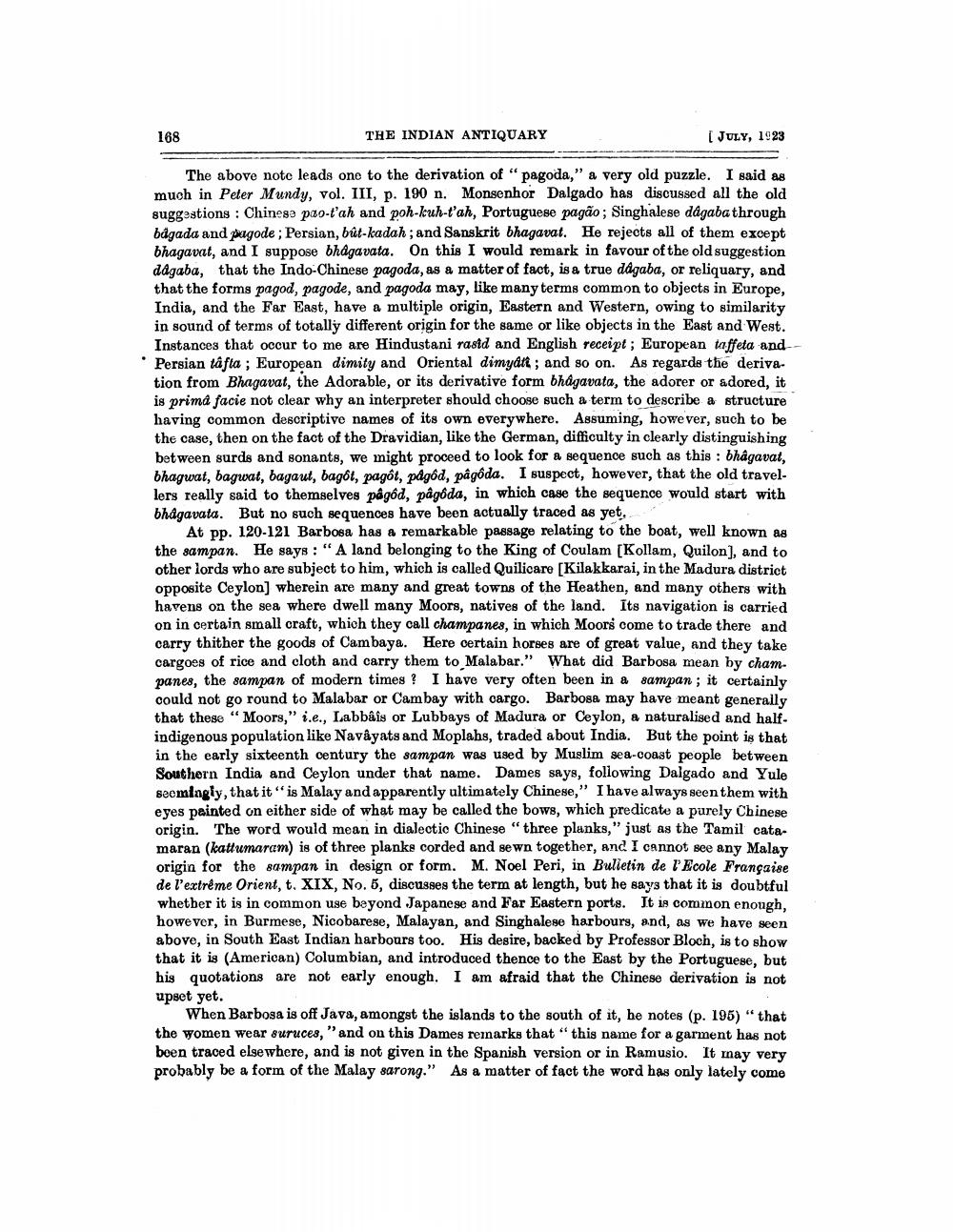________________
168
THE INDIAN ANTIQUARY
[ JULY, 1923
The above note leads one to the derivation of "pagoda," a very old puzzle. I said as much in Peter Mundy, vol. III, p. 190 n. Monsenhor Dalgado has discussed all the old suggestions: Chinese pao-t'ah and poh-kuh-t'ah, Portuguese pagão; Singhalese dagaba through bagada and pagode; Persian, bût-kadah; and Sanskrit bhagavat. He rejects all of them except bhagavat, and I suppose bhagavata. On this I would remark in favour of the old suggestion dagaba, that the Indo-Chinese pagoda, as a matter of fact, is a true dagaba, or reliquary, and that the forms pagod, pagode, and pagoda may, like many terms common to objects in Europe, India, and the Far East, have a multiple origin, Eastern and Western, owing to similarity in sound of terms of totally different origin for the same or like objects in the East and West. Instances that occur to me are Hindustani rasid and English receipt; European taffeta and Persian tâfta; European dimity and Oriental dimyatt; and so on. As regards the deriva. tion from Bhagavat, the Adorable, or its derivative form bhagavata, the adorer or adored, it is prima facie not clear why an interpreter should choose such a term to describe a structure having common descriptive names of its own everywhere. Assuming, however, such to be the case, then on the fact of the Dravidian, like the German, difficulty in clearly distinguishing between surds and sonants, we might proceed to look for a sequence such as this: bhagavat, bhagwat, bagwat, bagaut, bagôt, pagôt, pågôd, pâgôda. I suspect, however, that the old travellers really said to themselves pâgód, pagoda, in which case the sequence would start with bhagavata. But no such sequences have been actually traced as yet.
At pp. 120-121 Barbosa has a remarkable passage relating to the boat, well known as the sampan. He says: "A land belonging to the King of Coulam [Kollam, Quilon], and to other lords who are subject to him, which is called Quilicare [Kilakkarai, in the Madura district opposite Ceylon] wherein are many and great towns of the Heathen, and many others with havens on the sea where dwell many Moors, natives of the land. Its navigation is carried on in certain small craft, which they call champanes, in which Moors come to trade there and carry thither the goods of Cambaya. Here certain horses are of great value, and they take cargoes of rice and cloth and carry them to Malabar." What did Barbosa mean by champanes, the sampan of modern times? I have very often been in a sampan; it certainly could not go round to Malabar or Cambay with cargo. Barbosa may have meant generally that these "Moors," i.e., Labbâis or Lubbays of Madura or Ceylon, a naturalised and halfindigenous population like Navâyats and Moplahs, traded about India. But the point is that in the early sixteenth century the sampan was used by Muslim sea-coast people between Southern India and Ceylon under that name. Dames says, following Dalgado and Yule seemingly, that it "is Malay and apparently ultimately Chinese," I have always seen them with eyes painted on either side of what may be called the bows, which predicate a purely Chinese origin. The word would mean in dialectic Chinese "three planks," just as the Tamil catamaran (kattumaram) is of three planks corded and sewn together, and I cannot see any Malay origin for the sampan in design or form. M. Noel Peri, in Bulletin de l'Ecole Française de l'extrême Orient, t. XIX, No. 5, discusses the term at length, but he says that it is doubtful whether it is in common use beyond Japanese and Far Eastern ports. It is common enough, however, in Burmese, Nicobarese, Malayan, and Singhalese harbours, and, as we have seen above, in South East Indian harbours too. His desire, backed by Professor Bloch, is to show that it is (American) Columbian, and introduced thence to the East by the Portuguese, but his quotations are not early enough. I am afraid that the Chinese derivation is not upset yet.
When Barbosa is off Java, amongst the islands to the south of it, he notes (p. 195) "that the women wear suruces," and on this Dames remarks that "this name for a garment has not been traced elsewhere, and is not given in the Spanish version or in Ramusio. It may very probably be a form of the Malay sarong." As a matter of fact the word has only lately come




